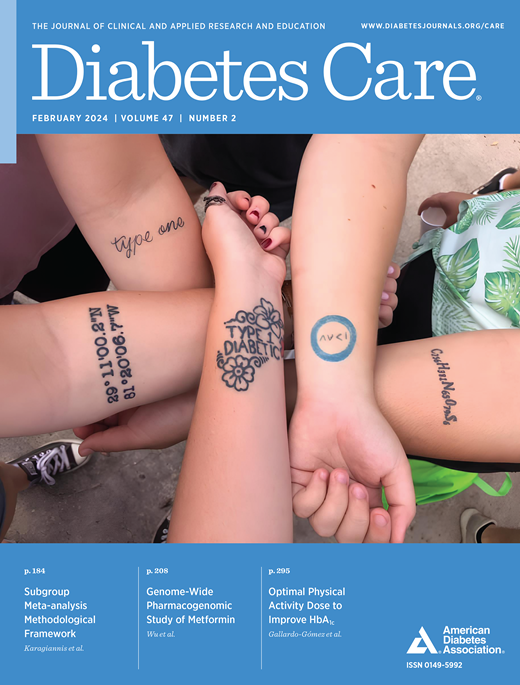血糖控制、磺脲类药物和胰岛素治疗对老年2型糖尿病患者跌倒和骨折风险的影响:一项观察性研究
IF 16.6
1区 医学
Q1 ENDOCRINOLOGY & METABOLISM
引用次数: 0
摘要
目的评估血糖控制、磺脲类药物和胰岛素治疗与老年2型糖尿病(T2D)患者因跌倒和骨折住院风险之间的关系。研究设计和方法本观察性队列研究使用了英国临床实践研究数据链GOLD与医院和死亡记录相关的数据。2000年至2017年期间发现的老年(≥70岁)T2D患者,如果在接受胰岛素或磺脲类药物治疗期间连续三次HbA1c测量≥7% (53 mmol/mol),则视为暴露。每个暴露的个体与三个未暴露的个体相匹配。结果包括因跌倒和骨折住院。灵活的参数生存模型,调整了社会人口和临床因素,以及相关的估计相对(危险比[HR])和绝对风险。结果:在21,365例患者中(暴露组n = 5,833例[27.3%]),因跌倒和骨折住院的调整相对风险比未暴露组略高(HR分别为1.04 [95% CI 0.96-1.11]和1.07 [95% CI 0.97-1.17])。暴露者因跌倒住院的10年绝对风险值(70-85岁人群15.6-36.8%)略高于未暴露者(15.1-36.0%)。绝对风险差异仍然很小(5年为0.2-0.6%,10年为0.5-0.8%)。结论:我们没有发现证据表明接受胰岛素或磺脲类药物治疗的老年T2D患者HbA1c≥7%与临床上有意义的跌倒或骨折风险增加之间存在关联。临床医生应继续平衡老年人血糖控制的益处和并发症的风险。本文章由计算机程序翻译,如有差异,请以英文原文为准。
Glucose Control, Sulfonylureas, and Insulin Treatment in Older Adults With Type 2 Diabetes and Risk of Falls and Fractures: An Observational Study
OBJECTIVE To estimate the association among glucose control, sulfonylureas, and insulin treatment with the risk of hospitalization for falls and fractures in older adults with type 2 diabetes (T2D). RESEARCH DESIGN AND METHODS This observational cohort study used U.K. Clinical Practice Research Datalink GOLD data linked to hospital and death records. Older adults (≥70 years) with T2D, identified between 2000 and 2017, were considered exposed if they had three consecutive HbA1c measurements <7% (53 mmol/mol) while receiving treatment with insulin or sulfonylureas. Each exposed individual was matched with to three nonexposed individuals. Outcomes included hospitalizations for falls and fractures. Flexible parametric survival models, adjusted for sociodemographic and clinical factors, and associated estimated relative (hazard ratio [HR]) and absolute risks. RESULTS Among 21,365 individuals (n = 5,833 [27.3%] in the exposed group), the adjusted relative risks of hospitalization for falls and fractures were marginally higher compared with those nonexposed (HR 1.04 [95% CI 0.96–1.11] and 1.07 [95% CI 0.97–1.17], respectively). The 10-year absolute risk values of hospitalization for falls were slightly higher in the exposed (range 15.6–36.8% in those aged 70–85 years) than nonexposed (15.1–36.0%) individuals. Absolute risk differences remained minimal (0.2–0.6% at 5 years and 0.5–0.8% at 10 years). CONCLUSIONS We found no evidence of an association between sustained HbA1c <7% while receiving insulin or sulfonylurea therapy and clinically meaningful increased risks of falls or fractures in older adults with T2D. Clinicians should continue to balance the benefits of glycemic control with the risks of complications in older adults.
求助全文
通过发布文献求助,成功后即可免费获取论文全文。
去求助
来源期刊

Diabetes Care
医学-内分泌学与代谢
CiteScore
27.80
自引率
4.90%
发文量
449
审稿时长
1 months
期刊介绍:
The journal's overarching mission can be captured by the simple word "Care," reflecting its commitment to enhancing patient well-being. Diabetes Care aims to support better patient care by addressing the comprehensive needs of healthcare professionals dedicated to managing diabetes.
Diabetes Care serves as a valuable resource for healthcare practitioners, aiming to advance knowledge, foster research, and improve diabetes management. The journal publishes original research across various categories, including Clinical Care, Education, Nutrition, Psychosocial Research, Epidemiology, Health Services Research, Emerging Treatments and Technologies, Pathophysiology, Complications, and Cardiovascular and Metabolic Risk. Additionally, Diabetes Care features ADA statements, consensus reports, review articles, letters to the editor, and health/medical news, appealing to a diverse audience of physicians, researchers, psychologists, educators, and other healthcare professionals.
 求助内容:
求助内容: 应助结果提醒方式:
应助结果提醒方式:


